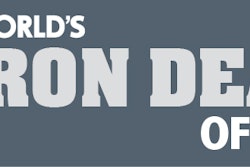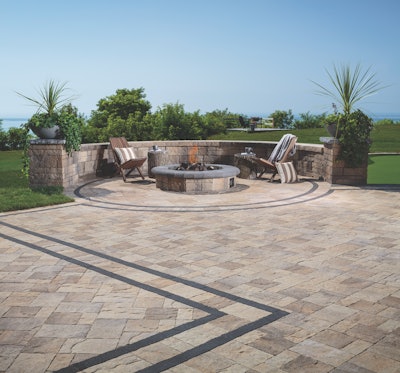 Photo: Belgard
Photo: BelgardAs a landscape and hardscape contractor, you know better than anyone that what’s on the outside of the home matters just as much as the indoor elements in terms of ROI and overall value. In fact, the National Association of Realtors’ 2018 Remodeling Impact Report notes that landscaping accounts for roughly 20 percent of a home’s value.
As such, upgrading outdoor elements and curb appeal with new flowers, greenery, pavers and more increases the value of the home and/or resale value for the homeowner. From simple borders to elaborate inlaid designs, incorporating an accent of a differing paver style, texture, shape or color can add a creative touch to any project.
Choosing the right paver
It’s important to work with the homeowner to decide whether they would like to install permeable or impervious pavers. Although traditional pavers may be lower in overall cost, there are many benefits to installing permeable pavers.
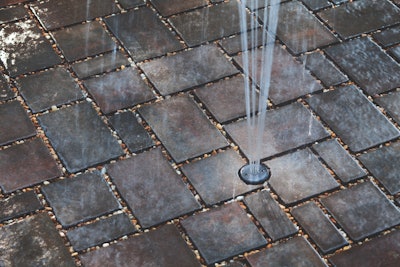 Permeable pavers help reduce standing water.
Permeable pavers help reduce standing water.Photo: Belgard
Permeable pavers offer a number of benefits for both homeowners and communities. For homeowners, permeable pavers:
- Reduce water demand by paving over natural areas
- Aid landscaping by reducing erosion that occurs when grass is dry and dead
- Eliminate standing water where mosquitoes can breed
- Last much longer than conventional paved surfaces
These environmental benefits also extend to communities:
- Filter water back underground to recharge local groundwater supplies
- Maintain base flows in rivers to keep ecosystems self-sustaining
- Minimize heat island effect when using highly reflective, light-colored pavers
- Reduce water use for landscaping
Paver colors
Homeowners today are increasingly looking for designs to bring the indoors out and choosing features within their outdoor spaces that seamlessly integrate experiences between the two environments. As such, keep the architectural style of the home in mind to ensure your proposed product choices and design work cohesively with the home’s current color or architecture.
- Grey and greige: Simple, soft and neutral colors like gray and taupe blend with clean design lines to create approachable, modern outdoor spaces that might feature contemporary large-form or porcelain pavers.
- Coral hues: Taking inspiration from Pantone’s Color of the Year, Living Coral, some pavers have hues of coral incorporated into the color blend. There are also many paver styles with complementary colors that can work well in conjunction with Living Coral.
Traditional patterns and styles
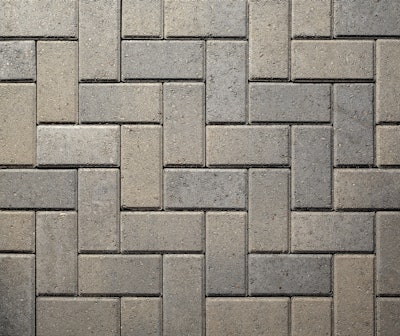 Herring bone
Herring bonePhoto: Belgard
For those who like to go with a tried-and-true style, consider rectangular and cobble-style pavers laid into a traditional pattern. These patterns work especially well in smaller spaces that can be overwhelmed by larger styles of pavers.
- Running bond: A running bond pattern is one in which the pavers are laid in rows running in the same direction. You can either go with a classic running bond, or consider getting creative with color tones, borders and pattern direction.
- Herringbone: Create a traditional look by laying pavers in a zig-zag, herringbone pattern. To add additional pop to a herringbone design, consider adding a contrasting border along the patio edges.
- Basket weave: This pattern utilizes rectangular pavers to create block designs. To add contemporary flair to this traditional laying pattern, you can alternate the color tones or laying direction to create modular designs.
Nontraditional shapes and designs
- Contemporary and modular: Modular shaped pavers offer a variety of square and rectangular sizes that can be laid in multiple laying patterns for a less repetitive, visually dynamic and contemporary look that works especially well for larger patios.
- Asymmetrical or random: Asymmetrically shaped pavers create a natural look and often incorporate false joints that create the illusion of multiple shapes laid at random. Multi-shape cobble-style pavers can also be laid in a multi-piece pattern that emulates a more random look, as an alternate to using a traditional laying pattern.
- Permeable: For permeable paver installations, it’s best to use ashlar or herringbone patterns to create more narrow joints. Large joints create an increased opportunity for shifting when used with running bond or basket weave patterns.
Border options
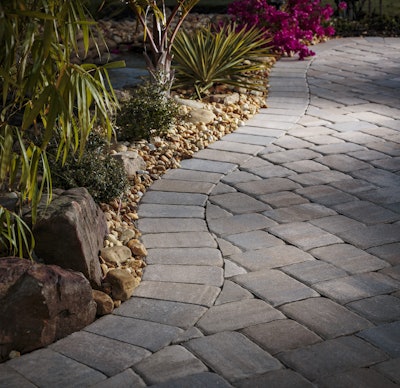 The soldier course is likely the most-used laying pattern for a paver border. Photo: Belgard
The soldier course is likely the most-used laying pattern for a paver border. Photo: BelgardCurrent trends lean toward coordinating colors that tie in with the roof color of the home, either in the primary paver field or in a border. Borders can make pavers pop in many ways, including using the same paver in a different color or different laying pattern or installing a contrasting paver shape, texture, color and/or style for the border. However, patio border designs can add an entirely new dimension to a patio’s laying pattern.
- Soldier course: The soldier course is likely the most-used laying pattern for a paver border. For this pattern, rectangular pavers are laid in a row, side-by-side.
- Sailor course: Another popular border, the sailor course lays rectangular pavers lengthwise in one or more rows. For additional visual interest, wide sailor course borders can be created using more than one type of paver.
- Inlaid: Striking paver patterns and designs can be created by laying a contrasting patio border further inside the paver field.
Creative touches
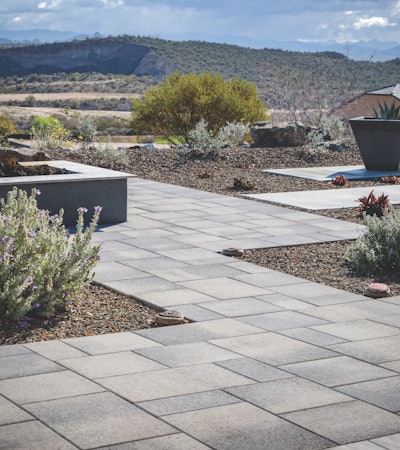 Photo: Belgard
Photo: BelgardVarying patterns and colors can be used to add unique elements to a patio, driveway or walkway, which can add visual interest to a hardscape design.
- Accents: Focal points can be created using pattern embellishments and accents by using multiple paver styles, or simply by using contrasting colors, shapes and/or laying patterns of the same paver style. Add character with contemporary focal points using squares or rectangles.
- Boundaries: Paver patterns and borders can be used to indicate the transition from one outdoor room to another. In addition, an inlaid faux rug design reinforces the outdoor room concept and helps define each space.
Innovation in the landscape and hardscape industry is at an all-time high, and the sky is the limit when creating outdoor living spaces with pavers. From varying color and laying patterns to intricate accents and designs, the addition of pavers can prove fast, efficient and profitable for contractors and homeowners alike.
EDITOR’S NOTE: Joe Raboine is the director of residential hardscapes at Belgard. He works to ensure that Belgard’s contractors and dealers are receiving best in class service, products and experiences. Joe started his career as a contractor over 25 years ago. For more information, visit www.Belgard.com or visit www.belgard.com/professional-resources to learn about Belgard’s products and partner programs.



